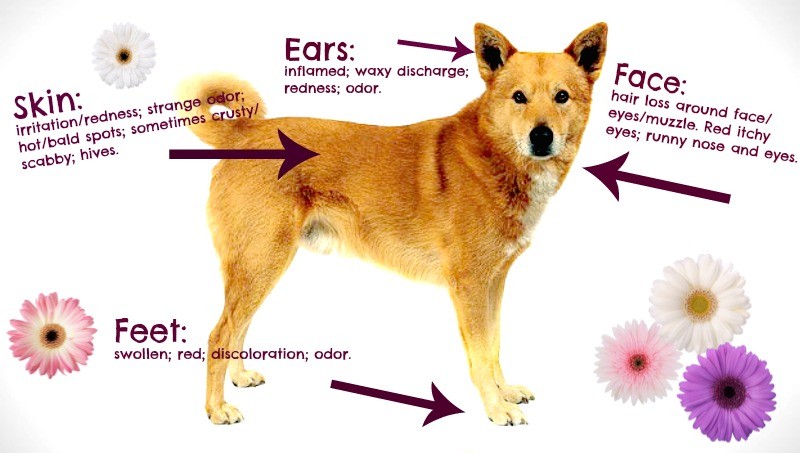What are dog allergy symptoms?
The most common symptom associated with allergies in dogs is itching of the skin, either localized (in one area) or generalized (all over the body). In some cases, the symptoms involve the respiratory system, with coughing, sneezing, and/or wheezing. Sometimes, there may be runny discharge from the eyes or nose. In other cases, the allergic symptoms affect the digestive system resulting in vomiting and diarrhea.
Symptoms of Allergies in Dogs
The symptoms of allergies in dogs may vary depending on the cause. A dog that goes into anaphylactic shock, for instance, will have a drop in blood sugar followed by shock, which is very different from a skin condition.
In general, however, the following symptoms could be a sign of an allergic reaction.
- Itchiness
- Hives
- Swelling of the face, ears, lips, eyelids, or earflaps
- Red, inflamed skin
- Diarrhea
- Vomiting
- Sneezing
- Itchy ears
- Chronic ear infections
- Itchy, runny eyes
- Constant licking
 **Image Courtesy of Friendship Hospital
**Image Courtesy of Friendship Hospital
Types of Allergies in Dogs
Allergies are a misguided reaction to foreign substances by the body’s immune system, which, of course, people and pets can suffer from. There are quite a few different types of allergies in dogs. Skin allergies, food allergies, and environmental allergens all pose challenges for dogs and their owners, and to make things more complicated, the symptoms of all these different types of allergies can overlap.
Skin Allergies
An allergy to fleas is the most common skin allergy seen in dogs. The bite of just one or two fleas per week is enough to make affected dogs itch. Flea saliva is believed to be the allergen that causes itchiness. The pet will bite and scratch itself and may remove large amounts of hair, especially in the tail-base region. A secondary bacterial infection may develop in the areas of broken skin.
Because one flea can be a problem, strict flea control is essential. Your veterinarian can give you tips on protecting your dog and other pets from fleas. When strict flea control is not possible, or in cases of severe itching, your veterinarian may prescribe antihistamines or corticosteroids (steroids) to block the acute allergic reaction and give immediate relief. If a secondary bacterial infection is present, an appropriate antibiotic will be prescribed.
Food Allergies
Food allergies are also known as adverse food reactions. Dogs can develop an allergy to a particular food at any point during their life, regardless of whether they have eaten these brands or types of foods in the past.
The most common food allergy for dogs develops in response to the protein of the food; dairy products, beef, wheat gluten, chicken, chicken eggs, lamb, and soy are commonly associated with food allergies in dogs. A food allergy may produce any of the clinical signs including itching, digestive disorders, and respiratory distress.
Treatment requires identifying the offending component(s) of the diet and eliminating them. The most accurate way of testing for food allergies is with an elimination diet trial using a hypoallergenic diet. Because it takes at least eight weeks for all other food products to be eliminated from the body, the dog must eat the special diet exclusively for eight to twelve weeks. If a positive response and improvement of your pet’s clinical signs occur, your veterinarian will advise you on how to proceed.
Environmental Allergies
Also known as atopy, seasonal or environmental allergies are caused by substances that exist in your home, backyard, and anywhere else your dog spends time.
These allergens can be inhaled, as with pollen, as well as absorbed through the skin when your dog touches them. Common triggers (allergens) for these allergic reactions include pollens, plant or animal fibers, dust mites, and mold spores.
Common symptoms include scratching/itchy skin, licking (especially the paws), and face rubbing. Affected dogs may also experience red skin, loss of fur, and recurrent skin and/or ear infections. You may see red skin or fur loss on your dog’s paws and lower legs, face, ears, armpits, and belly.
Caution: The symptoms of allergies can be confused with other disorders or occur concurrently with them. Therefore, do not attempt to diagnose your dog without veterinary professional assistance. Be prepared for your pet to receive a full diagnostic evaluation to rule out other causes of itching and skin problems. If an allergy is diagnosed, your whole family must follow your veterinarian’s advice very closely in order to successfully relieve your pet’s discomfort.
More Village Barker

How to Prevent Fleas
Flea prevention is an essential part of maintaining the health and well-being of dogs. Fleas are external parasites that can cause various problems, such as itching, skin irritation, and even...

Twelve Amazing Facts about Dogs
Dogs communicate through body language: Dogs use various body language cues to communicate their feelings and intentions. Tail wagging, ear position, facial expressions, and body posture are...

